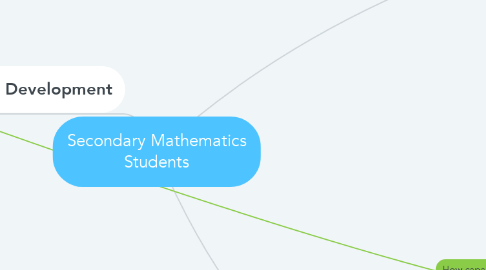
1. Physical Development
1.1. Puberty
1.1.1. Males
1.1.1.1. Changes in the genetal area
1.1.1.2. Pubic hair
1.1.1.3. Increased height and muscle development
1.1.1.4. Deepening of the voice
1.1.2. Females
1.1.2.1. Rapid increase in height and weight
1.1.2.2. Breast Development
1.1.2.3. Enlargement of the uterus
1.1.2.4. Pubic hair
1.2. Brain Development
1.2.1. Emergence of frontol lobe control
1.2.1.1. Explains risky behaviour
1.2.1.2. Less mature brain
1.2.1.2.1. Only seeing rewards and not the outcomes
1.2.1.2.2. A more mature brain will assess a situation before engaging in it
1.2.2. Cerebral cortex completed
1.2.2.1. Begins synapse pruning
1.2.2.1.1. Creates longer and stronger neural connections
1.2.2.1.2. Speeds up the communication in the brain
1.3. Language Development
1.3.1. Have a vocabulary of up to 50000 words
1.3.2. Increases in Vocabulary
1.3.2.1. Using connectives
1.3.2.2. Prefixes and suffixes
1.3.2.3. Use of more cohesive devices
1.3.2.3.1. Pronouns
1.3.2.3.2. Conjuctions
2. Cognitive Development
2.1. Piaget
2.1.1. Argued that how we think remains the same no matter the age
2.1.2. Children construst knowledge from experiences
2.1.3. Interaction is nessersary for cognitive development
2.1.4. Cognitive stages
2.1.4.1. Final Stage
2.1.4.1.1. The stage revelent to Secondary Students
2.1.4.1.2. The level at which a person demonstrates he capacity to think
2.1.4.1.3. Thinking about ones own thought
2.1.4.1.4. Abstract thoughts
2.1.4.1.5. Use of hypothetical reasoning
2.2. Vygotsky
2.2.1. Elementary Mental Functions develop into higher mental functions through social interactions
2.2.1.1. A more knowledgable other can can provide behavioural or verbal instructions
2.2.1.2. Zone of proximal development
2.2.1.2.1. Enhances the student by helping until they can reach a point where a student can do by themselves
2.2.1.3. Language
2.2.1.3.1. Silent inner speech and internal thought process
2.3. Bruner
2.3.1. Building on Vygotsky's theory Bruner used the term scaffolding
2.3.1.1. This theory suggests that a teacher supports the student and slowly reduces the amount of helped given to the student
2.4. Rogoff
2.4.1. Coganitive apprenticeships
2.4.1.1. Children should work along side adults for observation and listening
2.4.2. Guided participation
2.4.2.1. Children observe and then are supported to take part in the activity
3. Emotional Development
3.1. Self Concept
3.1.1. How we see ourselves, an image of ourselves
3.1.2. Academic self concept
3.1.2.1. Academic subjects
3.1.3. Non Academic self concept
3.1.3.1. Social
3.1.3.1.1. Peers
3.1.3.1.2. Friends
3.1.3.1.3. Family
3.1.3.2. Emotional
3.1.3.2.1. Emotional States
3.1.3.3. Physical
3.1.3.3.1. Ability
3.1.3.3.2. Apperence
3.2. Self Esteem
3.2.1. Opinion of yourself, feeling about yourself
3.2.1.1. Support from people around can affected esteem levels
3.3. Self Efficacy
3.3.1. How capable we believe we are at handling a task
3.3.1.1. Factors that affect self efficacy
3.3.1.1.1. Selection
3.3.1.1.2. Cognitive
3.3.1.1.3. Motivational
3.3.1.1.4. Affective
3.4. Australian Curriculum and general capabilites
3.4.1. Self awareness
3.4.1.1. Regonise emotion
3.4.1.2. Understand themselves as learners
3.4.1.3. Develop Reflective Practice
3.4.2. Self management
3.4.2.1. Empress emotions appropriately
3.4.2.2. Become confident, resilient and adaptable
3.4.2.3. Work independently and show initative
3.4.3. Social awareness
3.4.3.1. Appreciate diverse perspectives
3.4.3.2. Understand relationships
3.4.4. Social management
3.4.4.1. Work collaboratively
3.4.4.2. Communicate effictively

